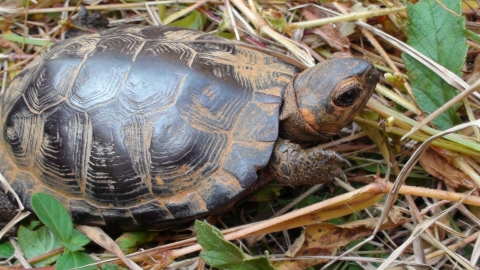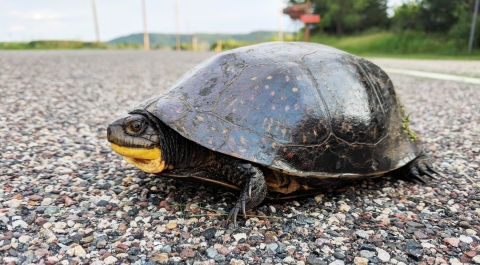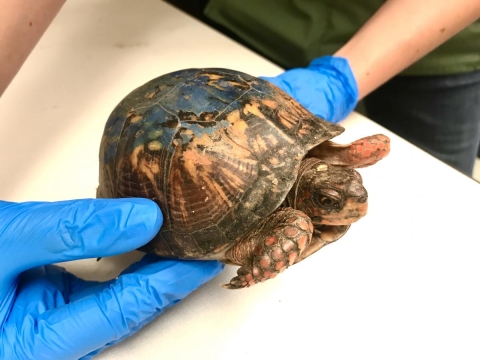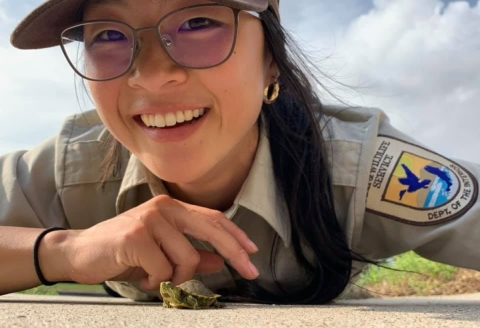Turtles have roamed our planet for more than 200 million years — they lived with dinosaurs! These diverse and fascinating reptiles play important roles in healthy habitats around the world.
Turtles are predators, prey, and ecosystem engineers. They spread seeds for plants, create habitat for other wildlife, and hold symbolic significance for many cultures.
You may consider turtles well protected because of their thick shells and, some might say, stern expressions. But wild turtles face a surprising number of threats both in the U.S. and abroad — from illegal collection to habitat loss to pollution. They need our help.
Turtles can be slow to reproduce, so every turtle counts when it comes to conservation. Turtles can live long lives if we let them. Learn how the Service and its partners protect turtles from these threats, and explore tips for what you can do to help!
How are turtles protected?
As of 2022, more than 49 species of land, aquatic, and sea turtles are protected as endangered or threatened under the federal Endangered Species Act (ESA). Several species are also protected by state law or international treaties or agreements, such as the Convention on International Trade in Endangered Species of Wild Fauna and Flora (CITES).
Sea turtles face a unique set of threats, including ocean pollution. All seven species of sea turtles found worldwide are protected under the ESA, CITES, or both as of this writing in 2022.
What about other turtle species across North America without federal protection? States, territories, and Tribes manage the rest. Although that includes turtles generally considered “common,” each species is unique and important to its native habitat. Turtles may also be vulnerable to illegal collection.
How does the U.S. Fish and Wildlife Service help turtles?
We work closely with public and private partners — including states, territories, Tribes, and international governments — on issues surrounding the pet trade and wildlife trafficking for species protected under federal laws, such as the ESA, Lacey Act, and the international treaty CITES.
We also manage public lands and waters, including national wildlife refuges and marine national monuments, to protect healthy habitats that benefit a wide variety of native wildlife, including turtles.
A national wildlife refuge is typically a contiguous area of land and water managed by the U.S. Fish and Wildlife Service for the conservation and, where appropriate, restoration of fish, wildlife and plant resources and their habitats for the benefit of present and future generations of Americans.
Learn more about national wildlife refuge . | Image Details
For turtles protected under the ESA, we develop recovery plans to guide conservation and work closely with partners to ensure these imperiled creatures endure in the wild for future generations.
In some cases, we even assist with captive breeding and release of rare turtles that need a boost. For instance, the gopher tortoise head start program led by our National Fish Hatchery System supports the recovery of this imperiled species by fostering tiny, hatchling turtles that are vulnerable to predation, giving them a better chance of survival when released months later — bigger and stronger.
Our Office of Law Enforcement works with partners such as local, Tribal and state law enforcement to protect turtles from exploitation.
State wildlife agencies, territories, and Tribes manage and protect local wildlife populations, including those not protected under federal laws. They are a great resource and, in some instances, may be a helpful first point of contact with any questions or concerns for non-federally protected species.
State, municipal, or county-level laws may also apply to turtles – as when reporting mistreatment of pets.
What obstacles do turtles face?
Habitat loss and fragmentation. Across the globe, habitat loss and fragmentation are the leading causes of wildlife declines. Turtles are no exception. Different turtle species evolved over millions of years to survive in a diversity of habitats, from wetlands to deserts. When the natural places they are adapted to become fragmented by development, degraded by pollution, or disappear entirely, turtles have nowhere else to go. If habitat loss happens across a species’ range, it may lead to extinction.
Roads and collisions. Vehicles pose a significant threat to slow-moving turtles as they cross roads, especially in the springtime when turtles are looking for new territory, or mating opportunities. Explore tips for helping a turtle safely cross roads, including never moving them to a different location.
Mistreatment as pets. Turtles need specialized care for decades, so be sure you are ready for a long-term commitment. They require specific food, temperature, and other conditions to survive. Do your research before buying a legal pet turtle to make sure you can care for it properly. Only certain turtles can be legally owned as pets – this varies by state. Consider checking animal shelters for unwanted pet turtles before shopping.
- One alarming and recurring trend is painting of pet turtles. This practice is unsafe, dangerous, and cruel to turtles. You should never paint a live turtle, including its shell. Turtles grow between its scutes (the plates that make up a turtle’s external shell), so paint can impede the growth and health of a turtle. Additionally, chemical toxins may enter the turtle’s bloodstream through their shell, and noxious fumes can impair respiration.
Illegal wildlife trade. Always ask where a turtle came from before you consider buying one. Turtles less than four inches cannot be sold or distributed in the U.S. When in doubt, ask for the seller’s permit to sell turtles or contact your state wildlife management agency for advice. For information about bringing reptile pets to the U.S., visit the USDA’s Animal and Plant Inspection Service’s website.
Poaching. Help keep wildlife wild – do not remove turtles from their natural environment. Removing turtles from their native habitat can harm both the turtles themselves and other wildlife and plants by undermining the balance of complex natural communities.
How can you help turtles?
- Report wildlife crime. If you believe you have information related to a wildlife crime, please report it directly to our law enforcement officers: 1-844-FWS-TIPS (397-8477) or https://www.fws.gov/wildlife-crime-tips. When possible and safe to acquire, include screenshots, links, images, location, and any other relevant information to help with a potential investigation. Be situationally aware and trust your gut. Don't put yourself in harm’s way to document a wildlife crime.
Keep locations of wild turtles to yourself, especially online. It can be exciting to see turtles in the wild, and to share your discovery. But if you post a photo of a turtle online, don’t include information on where you found it. People may mine the internet for this information and use it to target sites. If you want help identifying a turtle you saw in the wild, reach out to a local nature center or your state wildlife agency.
- Bring an unwanted pet turtle to a shelter, or find it a new caretaker. If you are no longer able to care for a pet turtle, don’t release it into the wild. It’s unlikely to survive and could transmit harmful diseases to wild populations. Consult with your state wildlife agency or a wildlife rehabilitation center for help in finding a home for the animal. Explore the Don’t Let it Loose campaign to learn more.
- Learn more on public lands. Visit your nearby national wildlife refuge, national fish hatchery, and other local public lands or green spaces to learn which wildlife are native to the area, and what you can do to help. There may be things you can do on your land or in your community to support turtle habitat.
- Purchase Federal Duck Stamps. These stamps support more than birds. For every dollar spent on Federal Duck Stamps, 98 cents go directly to purchase habitat or acquire conservation easements for protection in the National Wildlife Refuge System.
- Purchase Save Vanishing Species (“Tiger”) Stamps. These stamps help more than tigers. They fund conservation projects around the world to help wildlife like sea turtles, elephants, great apes, and rhinos.
- Explore a career in wildlife conservation. Join our team! No matter your talents or background, a career in public service and conservation can be fulfilling and exciting. Explore job, fellowship, internship, and volunteer opportunities with the U.S. Fish and Wildlife Service.
- Learn more and spread the word about turtle conservation. Turtles are inspiring and charismatic creatures. Protecting them safeguards clean water, clean air, and a healthy ecosystem that benefits people, plants, and other native wildlife. Share with others why turtles are so fascinating, why they deserve our respect, and how people can help keep them wild.
- Read about our work to protect turtles, and more, on our Wild Turtle Week page.












